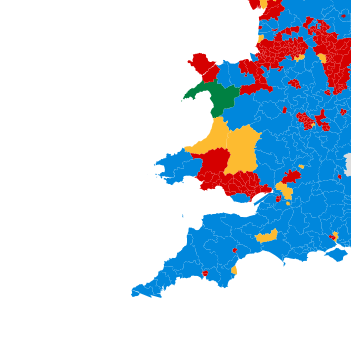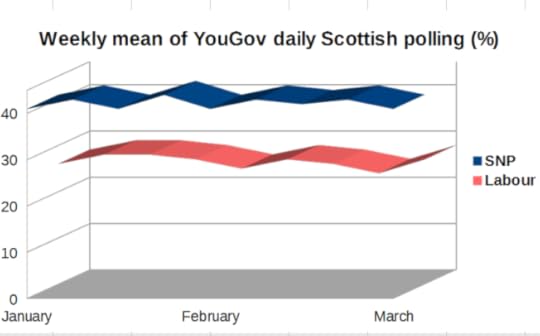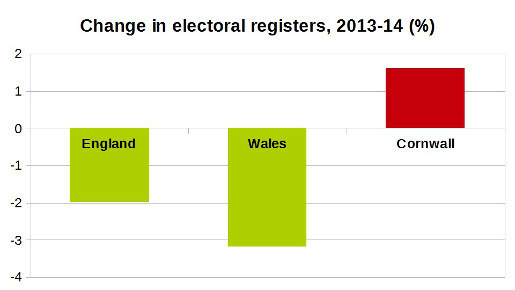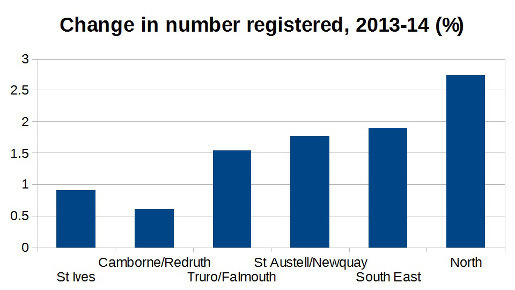Bernard Deacon's Blog, page 69
March 19, 2015
Who’s winning the Facebook war in Cornwall?
We’re told that the social media comprise an increasingly important battleground in the run up to the general election. The Westminster parties certainly appear to have taken this on board, all their candidates in Cornwall having Facebook pages. Strangely, the challenger parties seem less convinced.
Their candidates may blog regularly, but MK in particular seems reluctant to use Facebook, with only Stephen Richardson at Truro/Falmouth dipping his toe in the water. Ukip’s Graham Calderwood (St Ives), Bradley Monk in South East Cornwall and David Mathews at St Austell have no Facebook pages. Both Monk and Mathews have websites though and the young Monk is active on twitter. For the Greens, Steve Slade at St Austell/Newquay and Karen Westbrook (and before her Sharron Kelsey) at Truro/Falmouth are also not using Facebook to promote their electoral chances. Or at least no pages that I can find.
Looking at Facebook use by party, it seems that on average Greens (those that bother), Labour and Tory candidates make most use of the medium. Ukip and Lib Dem candidates are less keen, with a couple of exceptions (Andrew George at St Ives and Ukip’s Julie Lingard in North Cornwall). In fact, North Cornwall is the constituency where the social media scrap on Facebook is most vigorous, although even here Dan Rogerson is remaining aloof, or hiding, not using his Facebook page which steadily gathers dust. (Neither does his neighbour Steve Gilbert at St Austell, while his other Lib Dem neighbour Phil Hutty in South East Cornwall isn’t seen often on Facebook either).
So whose page is the most liked? Here’s the top ten as of 16th March.
Facebook Likes March 16th
1. Andrew George (LD, St Ives)
2,577
2. Sheryll Murray (Con, South East)
2,037
3. Michael Foster (Lab, Camborne)
1,454
4. George Eustice (Con, Camborne)
1,204
5. Steve Double (Con, St Austell)
949
6. Scott Mann (Con, North)
714
7. Amanda Pennington (GP, North)
544
8. Julia Goldsworthy (Con, Camborne)
434
=9. Bob Smith (Ukip, Camborne)
395
=9. John Hyslop (Ukip, Truro)
395
It may be no coincidence that Sheryll Murray and Michael Foster, one of whom viciously attacked the other with a mobile phone, are up at the top. But how are they getting their likes? The Tories at least have been discovered paying out vast sums of money amounting to over £100,000 a month linked to their Facebook activity. This presumably includes paying for likes.
Whose likes are growing at the fastest rate? Andrew George’s leapt up from 800 to over 2,500 in a week, which looks a bit odd. His Office of Andrew George MP Facebook page (catchy title) was amalgamated with his other page, but does that really explain all the growth? Not surprisingly, challenger parties, starting from a lower base, are seeing the biggest hike in their likes.
Change in Likes, 25th Feb-16th March
1. Andrew George (LD, St Ives)
+1,923
2. John Hyslop (Ukip, Truro)
+178
3. Bob Smith (Ukip, Camborne)
+116
4. Tim Andrewes (St Ives Greens)
+96
5. Amanda Pennington (GP, North)
+55
A more useful measure than likes, which can come from people in Sydney and San Francisco as easily as Saltash or Sennen, is the activity on Facebook and the engagement (how many are responding, liking, commenting or sharing posts). When it comes to activity, the hyper-active Murray and Foster are up there. But they’re both eclipsed by the most recently declared candidate, Labour’s John Whitby in North Cornwall. He’s frantically trying to track down Labour supporters in the north, who’ve been in hiding since the 1940s. Tough task.
Number of posts in week ending March 16th
1. John Whitby (Lab, North)
26
2. Sheryll Murray (Con, South East)
22
3. Michael Foster (Lab, Camborne)
20
4. St Ives Greens
19
5. Steve Double (Con, St Austell)
16
Meanwhile, turning to engagement per post the top achievers are as follows.
Engagement per post, 25th Feb – 16th March
1. Julia Goldsworthy (LD, Camborne)
103
2. Michael Foster (Lab, Camborne)
47
3. Simon Rix (LD, Truro)
23
4. Steve Double (Con, St Austell)
13
5. Sheryll Murray (Con, South East)
13
Julia Goldsworthy’s top post in the week ending the 16th was about a reduction in local First bus fares, which she claims was a result of a Lib Dem campaign. This campaign might have been unnecessary had not the evil Government slashed bus subsidies by 23%. Like the other Lib Dem candidates Julia seems to be suffering from a worrying memory lapse when it comes to recalling that the Coalition Government actually includes her own party. Michael Foster’s top posts were about privatisation plans for NHS services, which Labour would never do. Any more that is. As there were very similar privatisation plans back in 2006, when the government was of course ‘run’ by Labour.
Simon Rix at Truro was also expressing his ‘grave concern’ over the future of healthcare as a result of Tory and, errrr, Lib Dem policies of the past five years. The loquacious Steve Double’s top post told us all about pasty-making in St Dennis and his first job as a butcher. This ought to be good training for all those cuts his party is planning when the post-election butchering of public services resumes. Finally, Sheryll Murray’s top post was about Commonwealth Day, which she thinks is a jolly good thing despite the rest of us not noticing it. But nothing to do with Europe so it must be good.

March 17, 2015
Cornish Idiot’s Guide to the Budget
Wozzon with this Budget malarkey? Madderdoit? Here’s the budget made simple.
1) Economic growth
Imagine pasties was money. The more you eat the more you grow. Good for us, inna? Simple.
2) Sustainable growth
Go on eating pasties fer ever. No side effects. ‘Ansum.
3) Inflation
Result of eating too many of they pasties. Leads to quantitative pasty easing. Some scat up!
4) Productivity
Eat your pasties faster, not dreckly. Tizzardleeon, yeow.
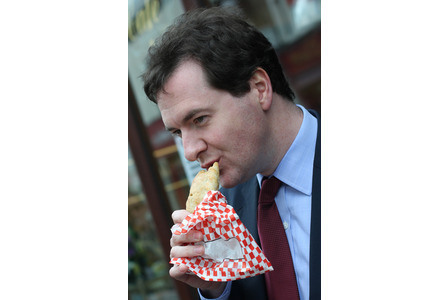 Enjoying a bacon sandwich moment, dear of’im
Enjoying a bacon sandwich moment, dear of’im5) Budget deficit
If we eat more pasties than we can afford we’ll be broke. Like Greece. ‘Ave to exist on hummus instead of fitty traade. Bleddy ‘ellup.
6) Cyclical budget deficit
The problem of eating pasties while on yer bike, ‘Specially if you’m pushing on in order to increase your productivity (see above).
7) Substitute goods
Swap boughten pasties fer ‘omemade. Beaudy.
8) Chancellor of the Hexchequer
Some cakey tosser grizzling all over his smarmy chacks. Probably get us all mazed, seemee.
9) Go’ment debt
A very bad thing. Will eventually produce a pasty shortage. Has to be prevented by things like pasty taxes and hosterity. And making sure the undeserving poor, ‘especially in Camburn, don’t get any more saffern buns.

March 16, 2015
Cornish Tories set to benefit from archaic voting system
Election Forecast is an academic collaboration involving psephologists from UEA, LSE and Durham. Its aim is is to predict the General Election outcome on the basis of a range of current polling data.
At present, it’s forecastiong a Tory clean sweep in Cornwall. That’ll occur with the Conservatives winning around 30-35% of the vote and 20-25% of the registered electorate. Surely we’re long overdue for real reform of a decrepit voting system.

March 15, 2015
Polls latest: Tory surge and Green slide? But all to play for.
It’s now less than eight weeks to the General Election. So let’s go compare this past week’s YouGov daily polling with that of eight weeks ago.
w/e March 13
w/e Jan 16
change
Conservatives
33.8%
31.8%
2.0%
Labour
32.6%
32.8%
-0.2%
Lib Dems
7.4%
6.4%
1.0%
Ukip
14.6%
16.0%
-1.4%
Greens
5.6%
7.0%
-1.4%
SNP/PC
4.8%
4.2%
0.6%
There’s not been a lot of movement over these months. Labour rose a bit and then fell a bit to end up back where it started. The Lib Dems have recovered a little from what was their low point in mid January. But they’ve now been flatlining for the past month. Ukip was on a temporary post-Christmas high eight weeks back but by the end of January was back at 14%, where it’s remained ever since. This is despite, or perhaps because of, a steady succession of gaffes, policy inconsistencies and the loss of various candidates after assorted racist outbursts.
 The SNP retains its post-referendum support and a healthy 15-20 point lead over Labour in Scotland. Indeed, this past week saw the biggest lead this year so far. The Tories’ threat of an SNP influence on government has if anything strengthened support for the SNP in Scotland. Or maybe that was their intention.
The SNP retains its post-referendum support and a healthy 15-20 point lead over Labour in Scotland. Indeed, this past week saw the biggest lead this year so far. The Tories’ threat of an SNP influence on government has if anything strengthened support for the SNP in Scotland. Or maybe that was their intention.
The biggest change is found among the Greens and the Tories. There’s been a steady drop in Green support since it peaked at 8% in the third week of January. Since then they’ve lost almost two and a half points. Even more of a disappointment for the Greens is that last week was the first since October when the Lib Dems scored higher than they did in every daily poll.
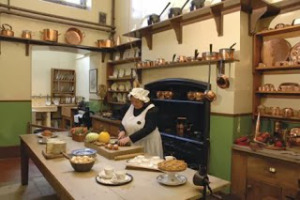 Revealed: Authentic Tory kitchen
Revealed: Authentic Tory kitchenMeanwhile, the Tory share of the poll has crept up to around 34% and they’ve now been ahead of Labour for three weeks running. No doubt the Tories will be hoping that their media continue to focus on important issues such as the size of Ed’s kitchen or his ability to eat a bacon sandwich rather than worrying us with distracting inconsequentials such as austerity and global warming. Expect another fillip this coming week as they spin the budget remorselessly and avoid any mention of the horrendous cuts and further privatisation they’re planning.
If we want to be gloomy we could extrapolate the polling shifts seen over the past eight weeks to the next eight and predict an election outcome something like this.
Share of the vote
Seats
Conservatives
35.8%
298
Labour
32.4%
279
Lib Dems
8.4%
11
Ukip
13.2%
0
Greens
4.2%
0
SNP/PC
5.4%
44
Which means that the only options will be a grand coalition between Tories and Labour (something both have been careful not to rule out) or a minority Labour Government with the support of both SNP and the rump of the Lib Dems, something that has been explicitly ruled out by Vince Cable. But can we trust the Lib Dems to stick to their word?
On the other hand, at the 2010 election there was considerable movement in the polls over the four weeks of the ‘short’ campaign in April/early May. In those weeks the Tories lost 3%, Labour lost 2%, the Lib Dems gained 4%, Ukip and the Greens both lost 1% while the others gained 2½% and doubled their share. These are much larger shifts than those we’ve seen so far this year. So there’s everything still to play for, especially after Easter.

March 14, 2015
Minority parties 4: Is there life left of Labour?
‘Though cowards flinch and traitors sneer, we’ll keep the red flag flying here’
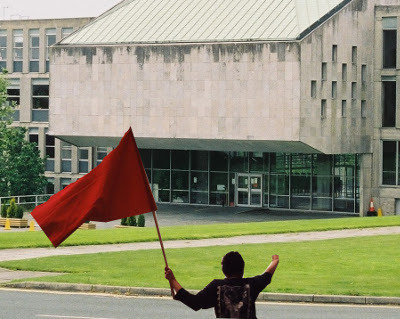 The assorted ragtag of cowards and traitors probably felt that socialism had been safely consigned to the dustbin of history with the victory of neo-liberalism in the 1980s and 90s. Not so. Taking inspiration from socialist parties in Europe, the socialist left is alive in Britain, while the jury is still out on its health. Mind you, it’s still prone to a dizzying and bewildering process of splits, expulsions and re-formations. Endlessly fascinating to those of us who willingly don our political anoraks, this can be a mite confusing to the casual observer, unschooled in the niceties of Trotsky’s Transitional Programme, the Leninist concept of the vanguard party or the details of Marx’s theories of surplus value. It also ensures that British socialist parties can still live up to Monty Python’s Peoples Front of Judea versus the Popular Front of the Judean People parody.
The assorted ragtag of cowards and traitors probably felt that socialism had been safely consigned to the dustbin of history with the victory of neo-liberalism in the 1980s and 90s. Not so. Taking inspiration from socialist parties in Europe, the socialist left is alive in Britain, while the jury is still out on its health. Mind you, it’s still prone to a dizzying and bewildering process of splits, expulsions and re-formations. Endlessly fascinating to those of us who willingly don our political anoraks, this can be a mite confusing to the casual observer, unschooled in the niceties of Trotsky’s Transitional Programme, the Leninist concept of the vanguard party or the details of Marx’s theories of surplus value. It also ensures that British socialist parties can still live up to Monty Python’s Peoples Front of Judea versus the Popular Front of the Judean People parody.
Socialist parties have three main family roots. The first is what could be called a left social democratic tradition. Although its roots are in that pre-Communist social democratic world, the oldest socialist party in Britain – the Socialist Party of Great Britain (SPGB) – can hardly be described as social democratic in the modern sense. This was (inevitably) a split from the Social Democratic Federation (a marxist party that was then affiliated to the Labour Party and which had a councillor in pre-WW1 Truro) way back in 1904. The comrades in the SPGB are hardly social democratic in the modern sense as they keep the fire of counter-reformism blazing merrily away.
It’s an impossibilist party. This means that in addition to it being impossible to see it save any deposits in the election, it sees reform within the capitalist system as pointless. The logic is therefore to call for revolutionary change that will sweep away a system geared to creating profits for the ruling class. In contrast to other revolutionary parties however, the SPGB has held on to the quaint belief that revolution can be achieved solely through the ballot box. Win enough seats and we can legislate capitalism away. These dreamers may be on a roll, as the 10 candidates they’ve announced for May is a ten-fold increase on their intervention in 2010.
The SPGB isn’t the only socialist party with venerable connections. The Socialist Labour Party (SLP) has a venerable leader in 77 year old Arthur Scargill. Breaking away from Labour after Blair binned Clause IV, the SLP is especially keen on renationalization. In the 1997 and 2001 general elections the party made a major effort, standing in 65 and 114 constituencies respectively. In those days it was the largest socialist party in terms of candidates (easily in 1997 when it supplied 58% of such candidates). But as Arthur has aged so the number of SLP candidates has fallen, to 49 in 2005 and just 23 in 2010. Many of those, as in Camborne-Redruth, were paper candidates and the average SLP vote has also drifted steadily downwards, from 1.8% in 1997 to just 0.8% in 2010. The party has announced eight candidates in Wales but none yet in England or Scotland. They may surpass their 2010 effort in number of candidates at least.
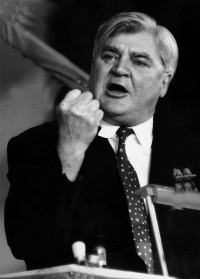 Nye Bevan – hero of British socialism
Nye Bevan – hero of British socialismThe youngest party in a Left Labour tradition is Left Unity. This emerged in a blaze of publicity in 2013, backed by Ken Loach and with an explicit appeal to the spirit of 1945 (NHS not rationing). It quickly gained 10,000 signatures of support, showing that Nye Bevan’s socialism may still have some pull. But membership settled down at 2,000 and has fallen since. Left Unity, which despite its name prefers not to enter into a full blown electoral alliance with other socialist groups, will be standing at least half a dozen candidates in May, a couple under a joint ticket with TUSC (see below).
The second tradition is that of Communism. Tied to Leninism and then hanging on to the coattails of Stalinism, Communists viewed the Soviet Union as a workers’ state and an improvement on capitalism. Given the history of the past half-century this position didn’t turn out to be too sustainable in the long run. However the Communist Party of Britain (CPB) is proud to acknowledge its roots in the former Communist Party of Great Britain, which loyally twisted and turned from the 1920s to the 1980s in deference to Soviet foreign policy. The CPB has stood half a dozen candidates in the last three general elections and this time announces eight, displaying a stubborn survivability at least. Rather bafflingly, two of their candidates are to be found in North Devon and Plymouth, places hitherto not particularly known for their mass support for the party of the working class and steadfastness in the struggle against deviationist tendencies.
Turning to the third tradition, we meet the equally hierarchical and even more authoritarian comrades in the various Trotskyite groups and sub-groups. Happiest when slagging off another Trotskyist sub-sect for counter-revolutionary tendencies, the Trot can always be counted on to give obscurantism a bad name. Before the 1980s in Britain Trotskyists mainly amused themselves by engaging in entryism. Not quite so dubious as it sounds, this involved entering the Labour Party under the fond delusion that they could convert it to socialism. More often the Labour Party converted the burrowing Trots into becoming Labour hacks. Even worse, several former Trotskyites found the transition from authoritarian Trotskyism to authoritarian Thatcherism a not too difficult step to make in the 1980s and 1990s.
One of the earliest entryist groups was the Socialist Labour League, formed in the 1950s, which later became the Workers Revolutionary Party (WRP). I can well remember the endearing and nostalgic sight of humourless WRP adherents who used to hang around factory gates and universities accosting worker and students trying to flog them their equally dour paper News Line. That said these days the formerly impenetrable News Line does carry the . Surviving a bitter round of splits and expulsions, the WRP rump has stood in just over half a dozen seats in recent elections, regularly garnering pitiful vote totals. They have yet to announce to the breathlessly expectant working masses whether their presence will grace ballot papers again in May.
 The revolution will be Cornish
The revolution will be CornishOne of the splits from the WRP was the Socialist Equality Party (SEP), which follows the line of its American big brother party of the same name. Vigorously opposing Scottish independence and noted for a fine line in condemning all others socialist parties as ‘pseudo-left organisations‘, the SEP opposes austerity and imperialist war but also hasn’t yet said whether it will repeat its experiment of 2010 when it stood a couple of candidates.
The largest, or at least formerly the largest, Trotskyite party is (or was) the Socialist Workers Party (SWP). Like the WRP, it can trace its roots back into the 1950s, being known before 1977 as International Socialists. For the ideologues of IS/SWP the USSR was bureaucratic state-capitalist, not a degenerated workers’ state, which apparently distinguished them from other socialist groups. The SWP’s secretive and cabalistic leadership clique made the most of broad front groupings to encourage recruitment into its ranks, for example the Anti-Nazi League in the 1970s and 80s. In 1999, the party joined with other socialist parties – the Socialist party (see below but not to be confused with the SPGB), Alliance for Workers Liberty, Workers Power and the Independent Socialist Network – in the Socialist Alliance. Boosted by the Stop the War Coalition against Blair’s Iraq adventure, 98 candidates stood under this banner in 2001, gaining an average vote of 1.7%.
However, by 2004 the Socialist Alliance was no more, as the SWP opted in 2003 to join with George Galloway and other disaffected Labourites in the Respect-Unity Coalition. This stood 26 candidates in 2005, gaining an impressive average 6.8% of the poll and getting gorgeous George elected, the first left of Labour success since the Communist Party back in 1945. But in 2007 Galloway and the SWP fell out as each struggled to control the organisation.
Galloway’s Respect went its own way, becoming Respect Renewal and standing 11 candidates in 2010. It succeeded in maintaining its 6.8% average vote share, far higher than any other socialist party, and since then Galloway has won a stunning by-election victory in Bradford West. But Respect has come to rely heavily on Muslim communities for its support. Even in those communities, its councillors rarely seem to stick with the party. By 2014 it had lost all its local council seats to defections. This wasn’t helped by Galloway’s crass remark in 2012 about the alleged rape committed by Julian Assange. He described Assange as just exhibiting ‘bad sexual etiquette’. This triggered the predictable departure of several of Respect’s most prominent female activists.
Unthinking misogyny wasn’t limited to Galloway on the socialist left. In 2013 an anonymous Comrade Delta high up in the leadership of the SW was exposed as a serial sexual harasser. The party leadership decided the matter was internal and closed ranks, stimulating accusations of cover-up and being apologists for rapists. This also led to major defections from the SWP in 2012-13. An alleged sexist attitude to women was also a factor in the downfall of the Scottish Socialist Party’s Tommy Sheridan and his subsequent jail sentence for perjury. Although here the charismatic Sheridan had been targeted by the now thoroughly discredited News of the World. Nonetheless, such coincidences across three socialist parties might suggest a deeper problem of misogyny among Trotskyite men, one that would certainly fit a psychology of morbid authoritarianism.
Recovering from their troubles of 2012-13, Respect has so far announced five candidates for May, including Galloway (all men however), while the SWP has joined the bigger electoral coalition known as the Trade Unionist and Socialist Coalition (TUSC). TUSC was launched specifically as a socialist electoral alliance for the 2010 election. It brought together socialists from parties such as the SWP with others from no party and left wing trade unionists, notably the late Bob Crow of the RMT plus members of the NUT, the Prison Officers Association, the PCSU and the Fire Brigades Union.
The political driving force behind the TUSC is the Socialist Party, which formerly had to contest elections as Socialist Alternative, as the SPGB had bagged the name Socialist Party. This, along with the SWP, is the largest of Britain’s small socialist parties. It can trace its roots back to the entryist Militant Tendency, quite influential in some parts of the Labour Party in the late 1970s and early 1980s. (In fact I distinctly remember a Militant militant assuring me just before the 1979 election that the working class in Camborne-Redruth were turning to Labour. They didn’t, preferring to turn to Thatcher. Such ingratitude!) Expelled by Kinnock, Militant came out as the Socialist Party in 1995. The party played a key role in the anti-poll tax campaign of 1989-90 and has a solid organisation based of course on Trotsky’s Transitional Programme. Moreover, the Socialist Party has so far remained untainted by the gender wars that have riven its rivals.
TUSC’s electoral presence has steadily grown since 2010. Last year they stood over 500 candidates in the local elections. This year, TUSC set itself the target of 100 parliamentary and 1,000 local candidates for May. While the 1,000 local candidates looks over-ambitious, TUSC has already announced the names of over 110 parliamentary hopefuls. This makes it the sixth largest all-Britain party and will guarantee it a party political broadcast. While the number of TUSC candidates grows apace, its vote remains frustratingly low and even at local elections fluctuates between the minute and the invisible, despite its resolute opposition to austerity policies. This is partly because it has little organisational presence between elections. It does have a handful of councillors, kindly expelled by Labour, in Southampton, Preston and Walsall and a couple directly elected onto Maltby Town Council (which is in South Yorkshire).
Nonetheless, TUSC and the Socialist Party are playing the long game. A regular presence on the ballot paper breeds familiarity and positions them to take electoral advantage of any sudden swing away from austerity politics or right wing populism. Remember that Syriza’s predecessor was only polling around 3% in Greece ten years ago. Or that Ukip only averaged 2.1% in 2001 come to that.
Finally, there are couple of socialist parties that don’t fit easily into either Labourism or the ‘democratic centralism’ of the Trot groups. The Scottish Socialist Party (SSP) was originally the Militant Tendency in Scotland but since the split in 2004, when Tommy Sheridan walked out to form Scottish Solidarity (now affiliated to TUSC), followed by Socialist Party adherents, the SSP has had no formal leadership. It favours democratic public ownership, an independent socialist Scotland and is against austerity and was arguing for a pro-yes alliance after last year’s failed referendum. This didn’t happen so a half dozen or so SSP candidates are likely to appear in May on a ‘distinct anti-austerity political’ platform. In fact the SSP in 2001 stood in 72 seats and scored a 3.1% average vote, higher than any other socialist party in Britain apart from Respect.
The final party in this blizzard of acronyms is the Alliance for Green Socialism, which provides a more libertarian bridge to green politics. This is a small grouping which has its focus on Leeds. It stood half a dozen candidates in 2005 and 2010 and three candidates have so far declared their intention to stand under its banner in May.

March 11, 2015
The strange death of the Cornish Liberal Party
As the Liberal Democrats drifted rightwards after the 1990s, the flame of traditional Liberalism – the radical Liberalism of Gladstone and the younger Lloyd George – was kept alive by the Liberal Party. This provided a home for those who couldn’t stomach the SDP and wanted a ‘radical, non-socialist alternative’.
The Liberal Party’s website sets out where it stands. It’s in favour of scrapping Trident, a land value tax, community-run NHS, abolition of league tables for schools, public ownership of water and rail and proportional representation. Oh, and ‘fundamental reform’ of an illiberal EU. Which all nicely ticks progressive boxes.
For a time the Liberal Party in Cornwall contested local and general elections and even had a county councillor. But now they’ve been co-opted by the fundamentally illiberal Ukip. Abandoning all those other progressive policies, they’ve decided that membership of the EU is the single most important issue facing us today.
So their ‘three candidates’ are withdrawing and they’re calling on their mass of supporters in Cornwall to vote Ukip. Strangely, this is the first time these suspiciously silent three mysterious and unnamed candidates have been heard of. The Liberal Party has kept them under wraps as a closely guarded secret up to now, and then promptly withdrawn them. Sadly, we shall never know who these brave men and women were.

March 10, 2015
The election outcome according to the bookies
What’s the current betting telling us about the result of the general election? The best odds available for Cornish seats are as follows.
Current best odds available
Con
Lib Dem
Ukip
Labour
Green
MK
Ind
NHAP
Camborne
8/13
8/1
16/5
28/1
100/1
150/1
100/1
North
5/4
5/6
16/1
150/1
100/1
South East
1/7
13/2
20/1
150/1
150/1
150/1
St Austell
4/6
5/2
9/2
150/1
100/1
250/1
St Ives
6/5
1/1
12/1
125/1
50/1
200/1
Truro
1/4
6/1
18/1
100/1
100/1
200/1
100/1
100/1
The bookies inform us that the Lib Dems stand little chance in Camborne and Redruth, Truro and Falmouth or South East Cornwall. Meanwhile, Steve Gilbert also looks unlikely to retain his seat at St Austell and Newquay, handing over to another Tory. Indeed, the money points to four Tories and two Lib Dems, although it might be worth taking a punt on the Tories to take all six Cornish seats.
Not much credibility is being given by punters to the Greens targeting of St Ives, while Ukip’s best chances on the basis of this is Camborne and Redruth, with only an outside chance at St Austell and Newquay. Nonetheless, it might be worth considering a punt on Ukip at St Austell, given these odds. Other bets worth considering on the basis of last year’s constituency polling might be for Lib Dems in St Austell or Labour in Camborne.
On the basis of the betting it looks like an uphill struggle for MK. 250-1 and the longest odds in Cornwall seems to greatly understate Dick Cole’s chances in St Austell however. And will MK really come behind both Independent and National Health Action Party candidates in Truro? Of course, betting odds merely reflect the weight of money being wagered. So MK supporters could always get down to the bookies and shift the odds. Or maybe they’d do better putting any spare cash into campaigning.
What do the odds more generally suggest for the election outcome? Here’s the prediction based on the betting.
General election seat outcome based on betting favourites
2015
2010
change
Conservative
275
306
-31
Labour
276
258
+18
Lib Dem
31
57
-26
SNP
41
6
+35
Plaid
3
3
Ukip
3
0
+3
Respect
1
0
+1
Irish and Speaker
19
19
If this is the outcome then not only will one party be unable to form a majority; no two parties will. In which case expect the German scenario and a grand coalition of Tories and Labour to save the system from collapse.

March 8, 2015
Polls panic: Labour ratchets up the politics of fear
The past week’s polls suggest nothing particularly shocking in England, Wales or Cornwall. The trends noted last week – the Ukip slide, Lib Dem recovery and Green fall-back, have all been halted in their tracks, at least temporarily. But one trend continues. Support for the Tories crept up again for the second week running and their slight lead over Labour widened a little.
w/e March 6
w/e Feb 27
change
Conservatives
34.0%
33.6%
+0.4%
Labour
33.6%
33.4%
+0.2%
Lib Dems
6.8%
7.6%
-0.8%
Ukip
14.6%
13.8%
+0.8%
Greens
6.2%
6.2%
no change
SNP/PC
4.2%
4.4%
-0.2%
While the polls are stable, this also means that the massive lead the SNP has enjoyed in Scotland since the referendum is stubbornly refusing to disappear.
Adding to Labour jitters, constituency polling last week suggested the SNP may be on course for a landslide win, not just taking a majority of Scottish seats, but demolishing Scottish Labour and Lib Dems in the process.
Cue increasing panic in the Labour ranks as we enter the last two months before the election. But instead of focusing on why it is unable to recover ground in England, the Labour leadership is resorting to dire warnings to the Scots. Apparently voting SNP will ‘wreak havoc’ and ‘allow David Cameron to regain power‘.
Really? This doesn’t seem particularly logical, given that the SNP, unlike other parties including Labour, has explicitly ruled out supporting a Tory Government after the election. That means that Cameron would be unable to cobble together enough votes for a coalition government even if the Tories emerge in May as the largest party.
Haven’t we been here before? Last summer, the unionist Labour-Tory coalition in Scotland was also spewing out dire threats in advance of the referendum as it feverishly ratcheted up the politics of fear. It worked then. So now they’re resorting to the same tactics. Labour doesn’t seem to realise that cosying up to the Tories in the unionist camp last year reduces the impact of its arguments that it’s somehow preferable to a Cameron Government. Labour no longer has a divine right to Scottish votes. But it’s only got itself to blame.

March 6, 2015
Cornwall bucks trend. Return of the second home voter?
The new system of individual electoral registration has led to a huge drop in the number of voters across England and Wales. Between December 2013 and December 2014 over 800,000 were lost from the electoral registers. Although a good proportion of this is accounted for by the end of block registrations of student halls of residence, it’s likely that the young, the transient and the poor have generally been more affected by the switch.
The Government says it’s all about ‘modernising’ the voting system (although refusing point blank to countenance any real modernisation that might reform our archaic 19th century first past the post system). In fact, its neatly fits into the dominant neo-liberal rationale, whereby the individual has to ‘take responsibility’, whether it’s getting a job, paying for tuition fees or healthcare, amassing capital, competing properly, or registering to vote. Failure to do this means you’re feckless or subversively denying your allotted role as consumer-citizen in the brave new (old) world orientated towards the selfishness of the comfortably-off.
But, as voter numbers tumble across Britain, take a look at the bar chart below.
That’s strange. Unlike elsewhere, the number of people registered to vote in Cornwall went up, not down. In Wales in all areas there was a fall in voter registration. Only a handful of local authorities in England – along the Welsh Marches from West Cheshire through Shropshire and Herefordshire, plus Rutland and Northamptonshire – show a similar increase. Of these, only Shropshire has seen a bigger rise than Cornwall.
This can’t just be due to population growth, which is running at around 0.6-0.7% a year, as the rise is more than double that. And local authorities where population is rising even faster than in Cornwall, like Lincolnshire or Norfolk, show the expected falls. It also can’t be due to greater efficiency in ensuring all new voters are registered. The number of ‘attainers’, those who reach voting age over the following year – collapsed in Cornwall from 3,426 in December 2013 to just 1124 in December 2014. This was double the average rate of fall in the number of young voters.
Let’s look at this by constituency.
Is it just a coincidence that North Cornwall has seen by far the biggest increase, with 1,746 more voters than it had a year ago, and Camborne & Redruth the lowest? Surely we can’t be seeing second home owners, removed from the registers between 2010 and 2014, sneaking back onto them, aided by the end of the council tax rebate for second homes which now makes it more difficult to identify them. And could there be an organised hand behind this, some body or party encouraging second home owners to register in Cornwall? Or is this merely paranoia?

March 5, 2015
Green and MK candidates pull out – opportunity for a pact?
Yesterday, another brace of candidates in Cornwall fell by the wayside. The Green Party’s Sharron Kelsey, fairly invisible in Truro & Falmouth, pulled out for ‘personal reasons‘. As did MK’s Orlando Kimber, who is no longer intending to stand in North Cornwall in order to devote more time to care for his wife, who is unwell.
MK will now need to restart its search for the 84 further candidates it needs in order to qualify for a party political broadcast. Or does it? Don’t these unwanted developments offer an unexpected opportunity for these two progressive parties to combine forces against the four conservative parties in Cornwall in these two constituencies?
In North Cornwall, the Green Party has had an excellent and energetic local candidate – Amanda Pennington – in the field for momnths. In Truro & Falmouth, MK’s Stephen Richardson is a commmitted socialist and sound on the critical issue of global warming, about which we’re hearing so much in the media in this campaign.
So here’s a modest suggestion. Instead of doing the predictably boring thing, why don’t the Greens and MK enter into a pact in these two seats and help to prevent splitting the progressive Cornish and environmentalist vote even further?

Bernard Deacon's Blog
- Bernard Deacon's profile
- 3 followers


